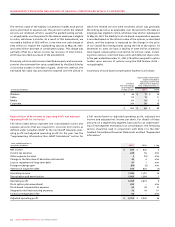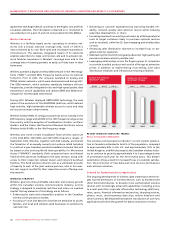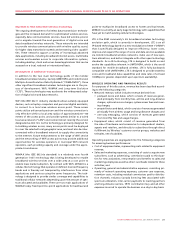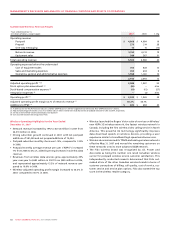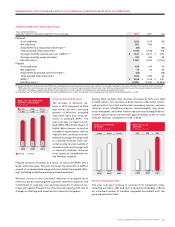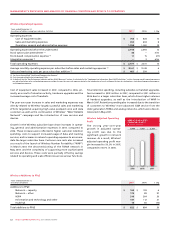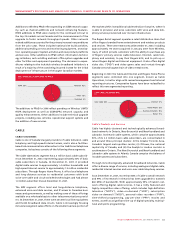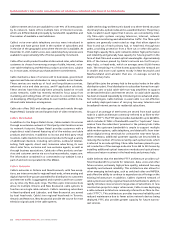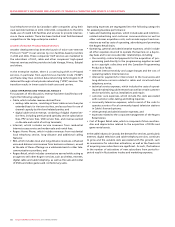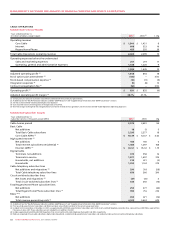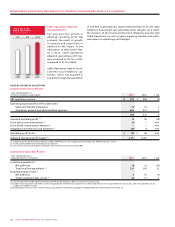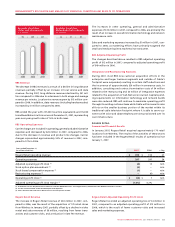Rogers 2007 Annual Report Download - page 37
Download and view the complete annual report
Please find page 37 of the 2007 Rogers annual report below. You can navigate through the pages in the report by either clicking on the pages listed below, or by using the keyword search tool below to find specific information within the annual report.
ROGERS COMMUNICATIONS INC. 2007 ANNUAL REPORT 33
MANAGEMENT’S DISCUSSION AND ANALYSIS OF FINANCIAL CONDITION AND RESULTS OF OPERATIONS
Additions to Wireless PP&E reflect spending on GSM network capac-
ity, such as channel additions and network enhancing features.
HSPA additions to PP&E were mainly for the continued roll-out to
the top 25 markets across Canada and the commencement of the
upgrade to faster network throughput speeds. Other network
related additions accounted for the primary increase in expenditures
from the prior year. These included national site build activities,
additional spending on test and monitoring equipment, sectoriza-
tion, operating support system activities and new product platforms
and services. Other additions to PP&E reflect information technol-
ogy initiatives, such as billing and back office system upgrades and
other facilities and equipment spending. The decrease in expen-
ditures relating to the Inukshuk wireless broadband initiative is a
result of a majority of the costs being incurred in 2006 for the initial
deployment of infrastructure in the largest Canadian markets.
The additions to PP&E for 2006 reflect spending on Wireless’ UMTS/
HSPA deployment as well as GSM/GPRS network capacity and
quality enhancements. Other additions include technical upgrade
projects, including new cell sites, operational support systems and
the addition of new services.
CABLE
CABLE’S BUSINESS
Cable is one of Canada’s largest providers of cable television, cable
telephony and high-speed Internet access, and is also a facilities-
based telecommunications alternative to the traditional telephone
companies. Its business consists of the following three segments:
The Cable Operations segment has 2.3 million basic cable subscrib-
ers at December 31, 2007, representing approximately 30% of basic
cable subscribers in Canada. At December 31, 2007, it provided
digital cable services to approximately 1.4 million households and
high-speed Internet service to approximately 1.5 million residential
subscribers. Through Rogers Home Phone, it offers local telephone
and long-distance services to residential customers with both
voice-over-cable and circuit-switched technologies and had almost
1.0 million subscriber lines at December 31, 2007.
The RBS segment offers local and long-distance telephone,
enhanced voice and data services, and IP access to Canadian busi-
nesses and governments, as well as making some of these offerings
available on a wholesale basis to other telecommunications provid-
ers. At December 31, 2007, there were 237,000 local line equivalents
and 35,000 broadband data circuits. Cable is increasingly focusing
its business segment sales efforts on the smaller business portion of
the market within its traditional cable television footprint, where it
is able to provision and serve customers with voice and data tele-
phony services provisioned over its own infrastructure.
The Rogers Retail segment operates a retail distribution chain that
offers Rogers branded home entertainment and wireless products
and services. There were 465 stores at December 31, 2007, including
approximately 170 stores acquired in January 2007 from Wireless,
many of which provide customers with the ability to purchase any
of Rogers’ primary services (cable television, Internet, cable tele-
phony and wireless), to pay their Rogers bills, and to pick up or
return Rogers digital and Internet equipment. It also offers digital
video disc (“DVD”) and video game sales and rentals through
Canada’s second largest chain of video rental stores.
Beginning in 2007, the Cable and Internet and Rogers Home Phone
segments were combined into one segment, known as Cable
Operations, to better align with revised management and internal
reporting structures. Comparative figures have been reclassified to
reflect this new segmented reporting.
Cable’s Products and Services
Cable has highly-clustered and technologically advanced broad-
band networks in Ontario, New Brunswick and Newfoundland and
Labrador. Its Ontario cable systems, which comprise approximately
90% of its 2.3 million basic cable subscribers, are concentrated in
and around three principal clusters: (i) the Greater Toronto Area,
Canada’s largest metropolitan centre; (ii) Ottawa, the national
capital city of Canada, and (iii) the Guelph to London corridor in
southwestern Ontario. The New Brunswick and Newfoundland and
Labrador cable systems in Atlantic Canada comprise the balance of
its cable systems and subscribers.
Through its technologically advanced broadband networks, Cable
offers a diverse range of services, including analog and digital cable,
residential Internet services and voice-over-cable telephony services.
As at December 31, 2007, more than 86% of Cable’s overall network
and 99% of its network in Ontario has been upgraded to transmit
860 MHz of bandwidth. With approximately 99% of Cable’s net-
work offering digital cable services, it has a richly featured and
highly-competitive video offering, which includes high-definition
television (“HDTV”), video-on-demand (“VOD”), subscription
video-on-demand (“SVOD”), personal video recorders (“PVR”),
time-shifted programming, pay-per-view (“PPV”) movies and
events, as well as a significant line-up of digital specialty, multicul-
tural and sports programming.
2007 WIRELESS ADDITIONS TO PP&E
(%)
HSPA 38%
Inukshuk 2%
Other 18%
Network 42%
2007 CABLE REVENUE MIX
(%)
Core Cable 43% Internet 17%
Home Phone 13%
Retail 11%
Business Solutions 16%



